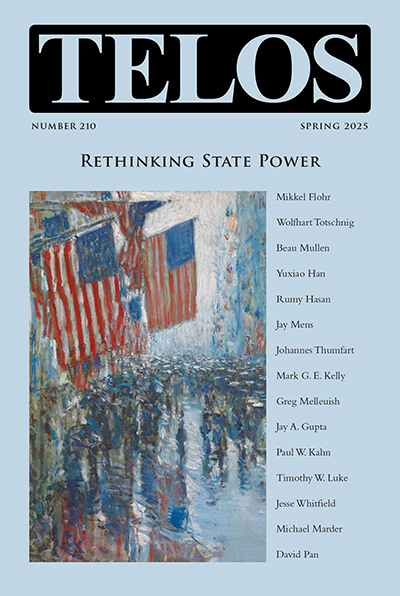The definition of asymmetry in asymmetrical warfare could, it seems, contribute to illuminating the link between war and politics, or war and peace. For Clausewitz, “War is a simple continuation of politics by other means.” Now, we could ask: what is the politics of asymmetrical warfare? Still following Clausewitz, war is “a wide-scale duel” and, as a duel or fight, war “takes two distinct forms: attack and defense.” Additionally, for Clausewitz, politics would be a form of “wide-scale commerce” between states. In his book Drone Theory, the French philosopher Grégoire Chamayou defines asymmetrical warfare as cynegetic (in other words, a form of hunt). He uses as an illustration the name of a recent model of unmanned vehicle: “the Predator,” le prédateur. But how can asymmetrical warfare be considered as war if the fight dynamic is absent? And if asymmetrical warfare is a manhunt, how could politics as commerce be possible?
|
David Pan’s “Carl Schmitt on Culture and Violence in the Political Decision” aims at challenging the widespread view that Carl Schmitt’s decisionism is motivated by violence and pure power. Pan presents his readers to “another Schmitt” that has escaped the attention of many commentators, including Müller, Žižek, McCormick, and Agamben. For Pan, Schmitt’s decision must not be separated from spiritual ideals and cultural values. “If, in addition, one imagines not only that airplanes fly through the airspace over land and sea but also that radio waves from transmissions from all lands circle the globe uninterruptedly through the atmospheric space, then it would be easy to believe now not only that a new, third dimension has been achieved but also that even a third element has been added, the air, as a new elementary domain of human existence. To both the mythic beasts, Leviathan and Behemoth, a third would be added, a great bird. But we must not be overhasty with such consequential propositions. Indeed, if one thinks of the mechanized technical means and energies with which human power is exercised in airspace, and if one recognizes the explosive motors by means of which air machines are moved, then it appears that it is the fire that is the additional, genuinely new element of human activity.” |
||||
|
Telos Press Publishing · PO Box 811 · Candor, NY 13743 · Phone: 212-228-6479 Privacy Policy · Data Protection Copyright © 2025 Telos Press Publishing · All Rights Reserved |
||||


